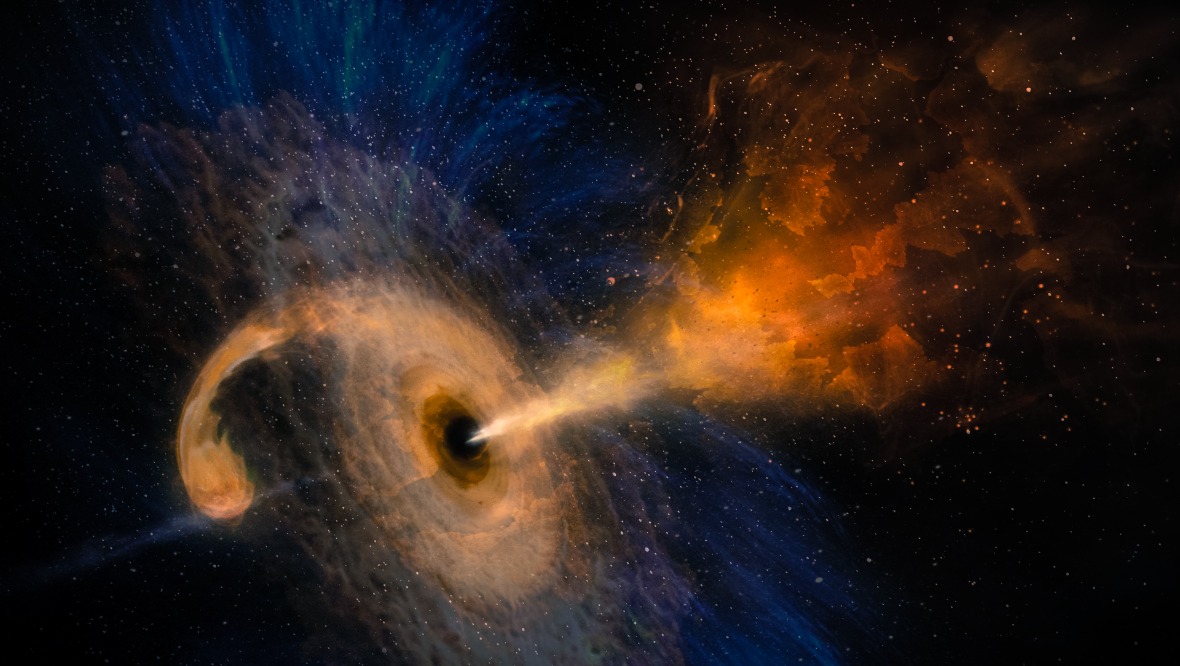The youngest black hole to date has been discovered 160,000 light-years from Earth.
Astronomers detected it by analysing the motion of a nearby star.
The groundbreaking method could help find others and shed light on how they form and evolve.
There are an estimated 100 million in the Milky Way alone, however just a couple of dozen have been spotted so far.
The black hole is 11-times larger than the sun which makes it tiny in comparison to some black holes, which can be billions of times bigger.
It lurks among a group of stars in the Large Magellanic Cloud (LMC), a neighbouring ‘dwarf’ galaxy.
Lead author Dr Sara Saracino, of Liverpool John Moores University, likened the technique to “Sherlock Holmes tracking down a criminal gang from their missteps”.
She explained: “We are looking at every single star in this cluster with a magnifying glass in one hand trying to find some evidence for the presence of black holes but without seeing them directly.
“The result shown here represents just one of the wanted criminals, but when you have found one, you are well on your way to discovering many others, in different clusters.”
The ‘smoking gun’ that put her on the trail was its gravitational force on the huge five-solar-mass star.
The distortion of its shape is due to the strong gravitational force exerted by the black hole – which also affects its orbit.
Normally, black holes are identified from the way they interact violently with an accreting disc of gas and dust.
As they shred this material, copious X-rays are emitted. It is this high-energy signal telescopes detect – not the black hole itself. Only a few do this.
In this unique case it was one of the stars, known collectively as NGC 1850, that gave the game away.
They are the brightest in the LMC, which lies in the southern constellation of Dorado, called the Goldfish or the Swordfish.
Co-author professor Stefan Dreizler, of the University of Gottingen, Germany, said: “The vast majority can only be unveiled dynamically.
“When they form a system with a star, they will affect its motion in a subtle but detectable way, so we can find them with sophisticated instruments.”
The international team used data collected by the European Southern Observatory’s Very Large Telescope (VLT) over two years.
Co-author professor Mark Gieles, from the University of Barcelona, said: “Every single detection we make will be important for our future understanding of stellar clusters and the black holes in them.”
It is the first time a black hole has detected among a young group of stars.
They are only around 100-million-years-old – a blink of an eye on cosmic scales.
It could lead to the unveiling of even more in similar clusters.
Comparing them with larger, more mature peers astronomers would show how they grow by feeding on stars or merging with other black holes.
What’s more, charting the demographics of black holes in star clusters improves our understanding of the origin of gravitational wave sources.
A scanner called MUSE (Multi Unit Spectroscopic Explorer) has been mounted on the VLT, which is located in Chile’s Atacama Desert.
Co-author Dr Sebastian Kamann, also from Liverpool, said: “MUSE allowed us to observe very crowded areas, like the innermost regions of stellar clusters, analysing the light of every single star in the vicinity.
“The net result is information about thousands of stars in one shot, at least ten times more than with any other instrument.”
This enabled the researchers to single out the odd star’s strange movement – signalling the presence of the black hole.
Data from the University of Warsaw’s Optical Gravitational Lensing Experiment and from the Hubble Space Telescope enabled them to measure the mass of the black hole.
ESO’s Extremely Large Telescope (ELT) in Chile, set to start operating later this decade, will allow astronomers to find even more hidden black holes.
Dr Saracino added: “The ELT will definitely revolutionise this field.
“It will allow us to observe stars considerably fainter in the same field of view, as well as to look for black holes in globular clusters located at much greater distances.”
It is believed almost every large galaxy – including the Milky Way – has a supermassive black hole at its heart. Nobody knows how they got there.
New telescopes and techniques are giving us better ways of looking at these giants.
They have a spherical boundary known as an “event horizon”. Within this sphere light, energy and matter are inescapably trapped.
The findings have been accepted for publication in Monthly Notices of the Royal Astronomical Society.
Follow STV News on WhatsApp
Scan the QR code on your mobile device for all the latest news from around the country


 iStock
iStock

























